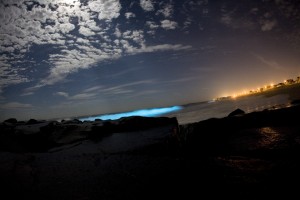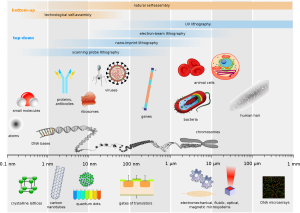The Glowing Sea
One of Earth’s Many Wonders
 Many have not had the chance to witness this great feat of Mother Nature in person, some don’t even believe it’s real. Many watched movies with beautiful glowing seas depicting mystical phenomenons that “just couldn’t be” part of real life. Well… Mother Nature truly is mystical and has come up with these beautiful displays of light called bioluminescence. In fact, nature has many different plants and animals that have bioluminescent capabilities appearing in her skies, lands and vast oceans. In this report I will be focusing on one of the smallest imaginable–Pyrocystis fusiformis
Many have not had the chance to witness this great feat of Mother Nature in person, some don’t even believe it’s real. Many watched movies with beautiful glowing seas depicting mystical phenomenons that “just couldn’t be” part of real life. Well… Mother Nature truly is mystical and has come up with these beautiful displays of light called bioluminescence. In fact, nature has many different plants and animals that have bioluminescent capabilities appearing in her skies, lands and vast oceans. In this report I will be focusing on one of the smallest imaginable–Pyrocystis fusiformis

P. fusiformis is a unicellular eukaryotic algae that is smaller than an ant! P. fusiformis can be identify by its elongated fusiform shaped body and tapered ends. It has an average length and width of 970 x 163 µm with the equivalent spherical diameter being 374 µm. To put their size in perspective an average human egg cell is approximately 1mm in size, which is 1,000 times bigger than a single micrometer (µm).
Here’s a link to a video of P. fusiformis being stimulated.
https://www.youtube.com/watch?v=UshqKYMdEfo
This stimulation is caused when the flask moves in circular motions agitating the water. This specific type of alga can be seen reacting to stimulation produced by the wakes of ships, swimming animals, in breaking surface waves, or from predator movement; the reaction is bioluminescence. Amazingly P. fusiformis can produce approximately 23-62 flashes per second, lasting 210 milliseconds, with a maximum photon intensity of 690 x 109 photons per second (these values are approximations for only the first flash).
CIRCADIAN RHYTHM Ooo…. what is it?
Circadian rhythm is a twelve hour light to twelve hour dark period of time. Circadian rhythm has played a role in many organisms life stages, reproduction processes, and eating habits. Particularly for this algae, the circadian rhythm plays a part in the transition from stage one to two and stage two, to three of their life cycle. More over, this process can also occur in a twenty-four hour dark period due to the amount of stored starches in this organism. There are 6 stages to their life cycle, and when placed in a dark place for an excess of 24 hours, the amount of various stage changes showing more 1,2,3, and 4 stages, where stage 5 and 6 are now not existent. This means that the 5th and 6th life stage requires light to occur.
Still with me? I know that was a lot to take in.

Here’s some ducks.
Back to the cute algae that we’re so interested in !
Cool fact about P. fusiformis is that at night (dark cycle) the chloroplasts(pigment) all move to the center of the cell surrounding the nucleus. It moves as much as 400 to 450 um twice each day. This changes the appearance of the specimen so that every night stage has a corresponding light stage, if the stage lasts more than twelve hours. -they’re shape shifters-
So, why did you read all of this? To further your knowledge of the amazing place we call home!? To one up your friend at a party? What ever your reasoning you will now have a greater understanding of our ocean and some of the critters in it! Most importantly you know what actually causes the glowing oceans; what first peaked your interest.
- https://microbewiki.kenyon.edu/index.php/Pyrocystis_fusiformis
- https://www.youtube.com/watch?v=UshqKYMdEfo
- https://www.youtube.com/watch?v=kEd6AYWK9uQ
- https://www.youtube.com/watch?v=kNhTba6t-Lo
- https://exploringtheinvisible.com/2013/11/21/c-mould-new-acquisition-pyrocystis-fusiformis/
- https://www.sciencedaily.com/terms/circadian_rhythm.htm
- Latz, Michael I., Jennifer C. Nauen, and Jim Rohr. “Bioluminescence response of four species of dinoflagellates to fully developed pipe flow.” Journal of Plankton Research 26 (2004): 1529-546.
- Latz, Michael I., Michelle Bovard, Virginia Van Delinder, Enrico Segre, Jim Rohr, and Alex Groisman. “Bioluminescent response of individual dinoflagellate cells to hydrodynamic stress measured with millisecond resolution in a microfluidic device.” The Journal of Experimental Biology 211 (2008): 2865-875.
- Foflonker, Fatima, and John Cowan. “Pyrocystis Fusiformis.”Https://microbewiki.kenyon.edu. Prof. Jay Lennon, 25 Aug. 2010. Web. 6 Mar. 2016.
- Sweeney, B. M. “Interaction of the Circadian Cycle with the Cell Cycle in Pyrocystis Fusiformis.” Plant Physiology 70.1 (1982): 272-76. Web.
- Swift, Elijah, Marc Stuart, and Valerie Meunier. “The in Situ Growth Rates of Some Deep-living Oceanic Dinoflagellates: Pyrocystis Fusiformis and Pyrocystis Noctiluca.” Limnol. Oceangr. Limnology and Oceanography21.3 (1976): 418-26. Web.
Samantha A’s blog post
 Comments(11)
Comments(11)